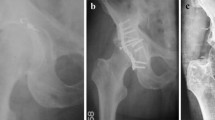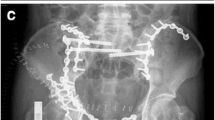Summary
This is a prospective study on the medium and long-term results of the operative treatment of 74 patients with a total of 75 acetabular fractures with at least 5 mm displacement, involving at least one column in a nine years period. Plain radiographs and CT scans were used pre- and postoperatively for evaluation of the reduction of fragments. The approaches used included the Kocher-Langenbeck, ilioinguinal, and extensile iliofemoral. The patients were followed for an average of 53 months (range 28–128 months). Postoperatively the radiographic fragment reduction was excellent in 44%, good in 36%, fair in 12% and poor in 8% cases, whereas the clinical results were 32%, 38%, 15% and 15% respectively. Complications were observed in 21 patients, but only in 11 (14%) were they associated with significant clinical impairment needing additional procedures. Particularly, heterotopic ossification (24%) and subcutaneous infection (1.3%) were mostly observed after extensile exposure (p<0.001), whereas posttraumatic arthrotic changes were noted in 6 and avascular femoral head necrosis in 4 additional patients. Two transient femoral nerve pareses were observed at the beginning of the learning curve with the ilioinguinal approach. The results show that the operative treatment of displaced acetabular fractures offers the experienced trauma surgeon good medium- and long-term results, reduces the risks of long bed-rest by allowing early mobilization, and reduces the rate of early and late complications.
Résumé
Il s’agit d’une étude prospective avec des résultats à moyen et à long terme du traitement chirurgical de 74 patients ayant une fracture du cotyle avec un déplacement d’au moins 5 mm et une fracture d’au moins une colonne, étudiés pendant une période de neuf ans. Des radiographies standards et des coupes scanographiques ont été utilisés en pré- et en post-opératoire pour l’évaluation de la réduction des fragments. Les voies d’abord utilisées ont été la voie de Kocher-Langenbeck, la voie ilio-inguinale ou une voie ilio-fémorale étendue.
Les patients ont été suivis avec un recul moyen de 53 mois (extrêmes 28 et 128 mois). La réduction radiologique contrôlée en post-opératoire était excellente chez 44% des cas, bonne dans 36%, moyenne dans 12% et médiocre dans 8%; les résultats cliniques selon les mêmes qualificatifs étaient respectivement de 32%, 38%, 15% et 15%. Des complications ont eu lieu chez 21 patients mais ne nécessitèrent une reprise chirurgicale que chez 11 patients (14%).
Des ossifications hétérotopiques dans 24% des cas et des infections sous-cutanées dans 1,3%, ont été plus vues dans les abords étendus (P<0,001) alors que les arthroses posttraumatiques ont été notées dans 6 cas et une ostéonécrose aseptique de la tête fémorale dans 4 cas. Deux parésies transitoires du nerf fémoral (crural) ont compliqué des abords ilio-inguinaux pendant la phase d’apprentissage chirurgical.
En conclusion, le traitement chirurgical des fractures déplacées du cotyle donne au chirurgien traumatologue des résultats satisfaisants à moyen et à long terme, réduit les risques dus au décubitus, permet la mobilisation immédiate et diminue le taux des complications précoces et tardives.
Similar content being viewed by others
References
Ayers D, Evarts C, Parkinson J (1986) The prevention of heterotopic ossification in high-risk patients by low-dose radiation therapy after total hip arthroplasty. J Bone Joint Surg [Am], 68: 1423
Bosse M, Poka A, Reinert C, Ellwanger F, Slawson R, McDevitt E (1988) Heterotopic ossification as a complication of acetabular fracture. J Bone Joint Surg [Am] 70: 1231
Bray T, Esser M, Fulkerson L (1987) Osteotomy of the trochanter in open reduction and internal fixation of acetabular fractures. J Bone Joint Surg [Am] 69: 711
Brooker A, Bowerman J, Robinson R, Riley L (1973) Ectopic ossification following total hip replacement. J Bone Joint Surg 55A: 1629
Cole DJ, Bohlhofner BR (1994) Acetabular fracture fixation via a modified Stoppa limited intrapelvic approach. Clin Orthop 305: 112
Copes WC, Champion HR, Sacco WJ, et al. (1988) The injury severity score revisited. J Trauma 28: 69
Goulet J, Bray T (1989) Complex acetabular fractures Clin Orthop 240: 9
Heeg M, Klasen H, Visser J (1990) Operative treatment for acetabular fractures. J Bone Joint Surg [Br] 72: 383
Helfet DL, Hissa EA, Sergay S, Mast JW (1991) Somatosensory evoked potential monitoring in the surgical management of acute acetabular fractures. J Orthop Trauma, 5: 161
Johnson EE, Eckardt JJ, Letournel E (1987) Extrinsic femoral artery occlusion following internal fixation of an acetabular fracture: A case report. Clin Orthop, 217: 209
Judet T, Judet J, Letournel E (1964) Fractures of the acetabulum: Classification and surgical approaches for open reduction. J Bone Joint Surg, 46A: 1615
Kaempffe FA, Bone LB, Border JR (1991) Open reduction and internal fixation of acetabular fractures: Heterotopic ossification and other complications. J Orthop Trauma 5: 439
Kebaish AS, Roy A, Rennie W (1991) Displaced acetabular fractures: Long-term follow-up. J Trauma 31: 1539
Letournel E (1961) Les fractures du cotyle, étude d’une série de 75 cas. J Chir 82: 47
Letournel E (1980) Acetabular fractures. Classification and Management. Clin Orthop 151: 81
Letournel E, Judet R (1981) Fractures of the acetabulum. Ed. 2 Berlin, Springer-Verlag, p. 32
Letournel E (1993) Open reduction internal fixation of acetabular fractures: Long-term results and analysis of 1040 cases: First International Symposium on the surgical treatment of acetabular fractures, Paris, France May 10–11
Matta JM, Anderson LM, Epstein HC, Hendricks P (1986) Fractures of the acetabulum: A retrospective analysis. Clin Orthop 205: 230
Matta JM, Letournel E, Browner BD (1986) Surgical management of acetabular fractures. In Anderson LD (ed.): AAOS Instructional Course Lectures, vol. 35. St. Louis, CV Mosby, p. 382
Matta JM, Mehne DK, Roffi R (1986) Fractures of the acetabulum: Early results of a prospective study. Clin Orthop 205: 241
Matta JM, Merritt PO (1988) Displaced acetabular fractures. Clin Orthop 230: 83
Mayo K (1987) Fractures of the acetabulum. Orthop Clin North Am 18: 43
McLaren A (1990) Prophylaxis with indomethacin for heterotopic bone. J Bone Joint Surg 72A: 245
Mears DC, Rubash HE (1983) Extensile exposure of the pelvis. Contemp Orthop 6: 21
Merle d’Aubigné R, Postel M (1954) Functional results of hip arthroplasty with acrylic prosthesis. J Bone Joint Surg 36A: 451
Moed B, Maxey JW (1993) The effect of indomethacin on heterotopic ossification following acetabular fracture surgery. J Orthop Trauma 7: 33
Nyhus LM (1989) The recurrent groin hernia. World J Surg 13: 541
Pantazopoulos T, Mousafiris C (1989) Surgical treatment of central acetabular fractures. Clin Orthop 246: 57
Probe R, Reeve R, Lindsey RW (1992) Femoral artery thrombosis after open reduction of an acetabular fracture. Clin Orthop 283: 258
Reinert CM, Bosse MJ, Poka A, et al. (1988) A modified extensile exposure for the treatment of complex or malunited acetabular fractures. J Bone Joint Surg 1988; 70A: 329
Routt MLC, Swiontkowski MF (1990) Operative treatment of complex acetabular fractures. Combined anterior and posterior exposures during the same procedure. J Bone Joint Surg 72A: 897
Rowe CR, Lowell JD (1961) Prognosis of fractures of the acetabulum. J Bone Joint Surg 43A: 30
Stoppa RE (1989) The treatment of complicated groin and incisional hernias. World J Surg 13: 545
Tile M (1991) Fractures of the acetabulum. In Rockwood Jr CA, Green DP, Bucholz RW (eds.) Roockwood and Green’s Fractures in Adults ed. 3, Vol 2. Philadelphia, JB Lippincott
Tile M, Helfet DL, Kellam JF, Letournel E, Matta JM (1992) Symposium: Management of acetabular fractures-Part I. Contemp Orthop 25: 301
Tile M, Helfet DL, Kellam JF, Letournel E, Matta JM (1992) Symposium: Management of acetabular fractures-Part II. Contemp Orthop 1992; 25: 389
Vrahas M, Gordon RG, Mears DC, Krieger D, Sclabassi RJ (1992) Intraoperative somatosensory evoked potential monitoring of pelvic and acetabular fractures. J Orthop Trauma 6: 50
Webb LX, Bosse MJ, Mayo KA, et al. (1990) Results in patients with craniocerebral trauma and an operatively managed acetabular fracture. J Orthop Trauma 4: 376
Winquist RA (1982) Open reduction and internal fixation of central acetabular fractures by anterior and posterior approach. Orthop Trans 6: 93
Author information
Authors and Affiliations
Rights and permissions
About this article
Cite this article
Korovessis, P., Stamatakis, M., Sidiropoulos, P. et al. Treatment protocol, results and complications of operative treatment of displaced acetabular fractures. Eur J Orthop Surg Traumatol 10, 99–106 (2000). https://doi.org/10.1007/BF02803104
Received:
Accepted:
Issue Date:
DOI: https://doi.org/10.1007/BF02803104




